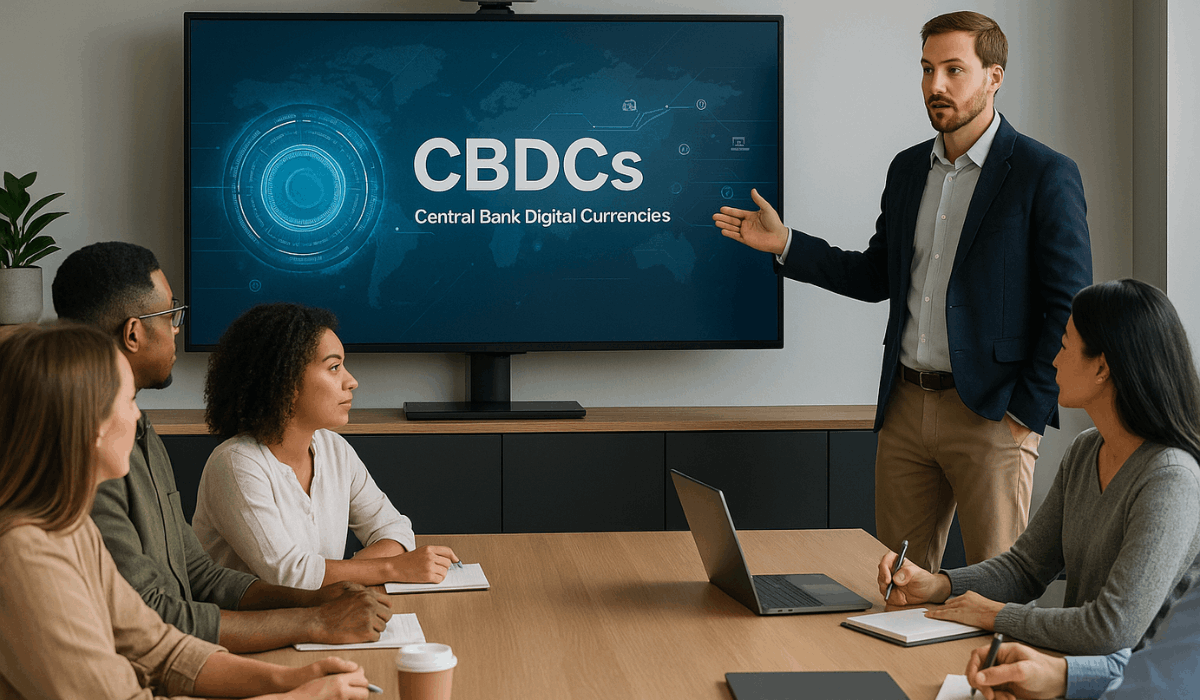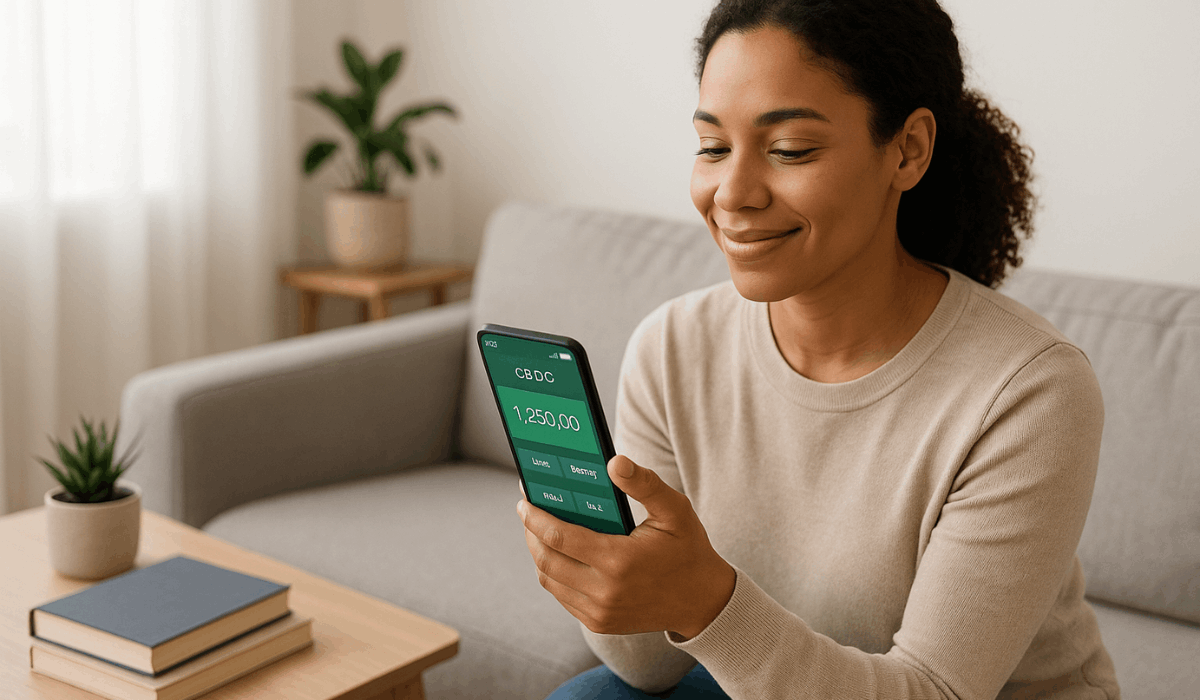Central Bank Digital Currencies (CBDCs) are digital versions of a nation’s official currency, issued and controlled by the central bank.
With more countries testing or launching them, CBDCs are quickly becoming part of the global financial landscape.
This article explains what CBDCs are and how they might affect how you use, save, and think about money.
What Are CBDCs?
Central Bank Digital Currencies (CBDCs) are digital forms of money issued directly by a country’s central bank.
They are legal tender and aim to provide a safer, more efficient alternative to cash and private digital currencies.
Types of CBDCs:
- Retail CBDCs – For everyday use by the public, like cash but digital.
- Wholesale CBDCs – Used by banks and financial institutions for large-scale transactions.

Why CBDCs Are Becoming Popular
Central banks around the world are exploring CBDCs in response to rapid changes in how people use money.
Several key factors are driving this shift toward digital currencies.
- Decline in cash usage – More people now prefer digital payments over physical cash.
- Rise of cryptocurrencies – Governments want a regulated alternative to private digital assets.
- Financial inclusion goals – CBDCs can give unbanked populations easier access to money.
- Faster and cheaper payments – Digital currencies can speed up transactions and lower costs.
- Stronger monetary control – Central banks can monitor money flows and respond faster to crises.
- Combatting financial crime – CBDCs make it easier to track and prevent illegal transactions.
What CBDCs Could Mean for You
CBDCs won’t just change how governments handle money—they’ll also impact your daily financial life.
Here’s how they could affect how you spend, save, and access your money.
- Faster payments – Send and receive money instantly, even on weekends or holidays.
- Lower costs – Fewer fees for transfers and purchases due to fewer intermediaries.
- No bank account needed – You could store digital currency in a wallet without relying on a traditional bank.
- Government benefits delivered faster – Direct payments like aid or subsidies could arrive instantly.
- Less privacy – Every transaction is traceable by the central authority.
- Offline payments – Some CBDCs may allow transactions even without internet access.
Pros and Cons of CBDCs
CBDCs come with both advantages and potential downsides. Understanding the pros and cons helps you prepare for how they might affect your finances.
Pros of CBDCs:
- Fast and secure payments – Speeds up everyday transactions with strong security.
- Reduces reliance on cash – Helps in situations where cash is impractical or unavailable.
- Financial inclusion – Offers access to money for people without bank accounts.
- Limits fraud and counterfeiting – Harder to forge than physical money.
- Improves crisis response – Governments can distribute aid or emergency funds quickly.
Cons of CBDCs:
- Privacy concerns – The government could track your transactions.
- Cybersecurity risks – Hackers or experienced outages could target systems.
- Bank disruption – People might pull money from banks, affecting their stability.
- Requires digital access – Not everyone has the devices or skills needed.
- Potential overreach – Central banks could restrict or monitor how you spend money.

How CBDCs Differ From Other Digital Options
CBDCs aren’t the same as the digital money you already use in apps or crypto wallets. Here’s how they stand apart from other digital options.
CBDCs vs. Cryptocurrencies
- CBDCs are government-issued and stable.
- Cryptocurrencies are decentralized and can be highly volatile.
- CBDCs follow national laws; most crypto operates without regulation.
CBDCs vs. Mobile Wallets
- CBDCs are the actual currency, not just a tool to store or move money.
- Mobile wallets like PayPal or GCash rely on bank accounts or cards.
- CBDCs could work without a bank, using just a digital ID or wallet app.
CBDCs Around the World
CBDCs are gaining traction globally, with some countries already using them and others running pilot programs or developing frameworks.
Here’s a snapshot of where different nations stand.
- China – The Digital Yuan is in advanced pilot testing across major cities and events.
- Nigeria – Launched the eNaira in 2021, aiming to improve financial inclusion and payment systems.
- Bahamas – Rolled out the Sand Dollar, the world’s first official CBDC, now available nationwide.
- Sweden – The Riksbank is testing the e-Krona to prepare for a possible cashless future.
- European Union – The Digital Euro is in the preparation phase, with legislation being developed.
- United Kingdom – Considering a “Digital Pound” (nicknamed Britcoin), with consultations underway.
- United States – The Federal Reserve is researching potential CBDC models but has not made a decision yet.
What This Means for Your Financial Future
CBDCs could reshape the way you manage, store, and spend money. Here’s what to expect as they become more common.
- Less use of cash – You might rely more on digital wallets than physical bills.
- New payment habits – Expect faster, app-based transactions everywhere.
- Direct government transfers – Wages, aid, or refunds could be paid straight to your digital wallet.
- Lower dependence on banks – You may not need a bank account to hold or send money.
- Greater focus on digital security – You’ll need to understand how to protect your money online.
- Possible spending limits or controls – Authorities might set rules on how CBDCs can be used.
What You Should Do Now
As CBDCs continue to roll out, it’s important to stay ready and informed. Here are practical steps you can take now to prepare for the shift.
- Follow official updates – Check your central bank’s announcements about CBDC plans.
- Learn how digital wallets work – Understand how to use and secure them.
- Stay alert to scams – New systems attract fraud attempts—verify sources before sharing info.
- Know your data rights – Find out how your transaction data may be stored or shared.
- Upgrade your digital skills – Learn basic online security and mobile banking tools.
- Explore alternative options – Stay aware of non-CBDC payment methods in case of tech issues.
FAQs About CBDCs
Many people still have questions about how CBDCs work and what they mean for everyday use.
Here are some quick answers to the most common concerns.
Will CBDCs replace cash?
- Not right away. Most countries plan to offer them alongside cash—for now.
Are CBDCs the same as crypto?
- No. CBDCs are issued by governments, while cryptocurrencies are decentralized and unregulated.
Will I need a bank account to use a CBDC?
- Not necessarily. Some CBDCs are designed to work through digital wallets without a bank.
Is my privacy at risk?
- Possibly. Governments may track transactions to prevent crime, which could reduce anonymity.
Can I use a CBDC offline?
- Some designs allow limited offline transactions, but not all countries support this yet.
Will using a CBDC cost anything?
- Most central banks aim to keep CBDC use free or very low-cost for users.
To Wrap Up
CBDCs are becoming a significant part of the future of money, with many countries already testing or launching them.
They offer speed and access, but also raise questions about privacy and control.
Stay informed and prepare early—start by learning how digital wallets work and watch your central bank’s updates.





